Old World monkey
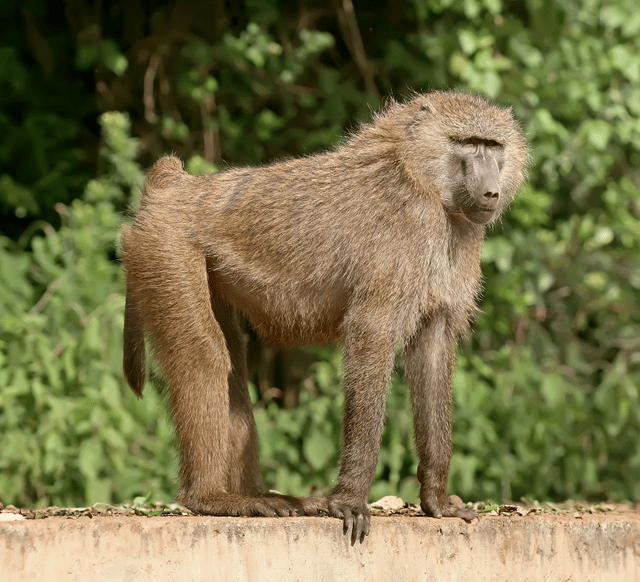
Old World monkey

| Old World monkeys[1] | |
|---|---|
| Olive baboon (Papio anubis) | |
| Scientific classification | |
| Kingdom: | Animalia |
| Phylum: | Chordata |
| Class: | Mammalia |
| Order: | Primates |
| Suborder: | Haplorhini |
| Infraorder: | Simiiformes |
| Parvorder: | Catarrhini |
| Superfamily: | Cercopithecoidea |
| Family: | Cercopithecidae Gray, 1821[2] |
| Type genus | |
| Cercopithecus Linnaeus, 1758 | |
| Subfamilies | |
| Cercopithecinae - 12 genera Colobinae - 11 genera sister: Hominoidea | |
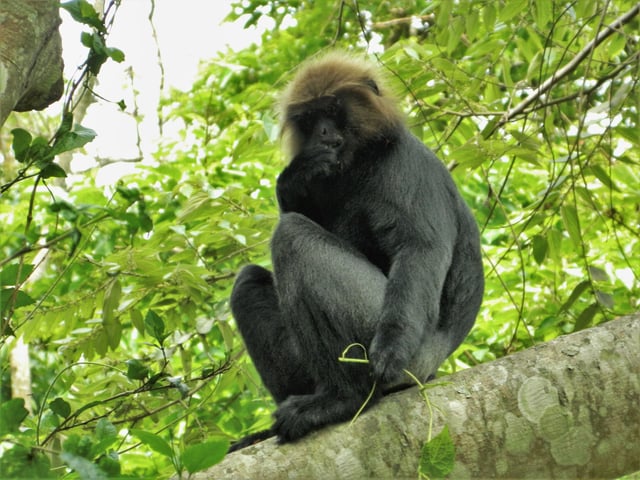
An adult Nilgiri langur in Periyar National Park and Wildlife Sanctuary, Kerala, India
The Old World monkeys is the common English name for a family of primates known taxonomically as the Cercopithecidae. Twenty-four genera and 138 species are recognized, making it the largest primate family. Old World monkey genera include baboons (genus Papio) and macaques (genus Macaca)'. Common names for other Old World monkeys include the talapoin, guenon, colobus, douc (douc langur, genus Pygathrix), vervet, gelada, mangabey (a group of genera), langur, mandrill, surili (Presbytis), patas, and proboscis monkey. Phylogenetically, they are more closely related to apes than to New World monkeys. They diverged from a common ancestor of New World monkeys around 55 million years ago.
The smallest Old World monkey is the talapoin, with a head and body 34–37 cm in length, and weighing between 0.7 and 1.3 kg. The largest is the male mandrill, at around 70 cm in length, and weighing up to 50 kg.[3] Old World monkeys have a variety of facial features; some have snouts, some are flat nosed, and many exhibit coloration. Most have tails, but they are not prehensile.
Old World monkeys are native to Africa and Asia today, inhabiting numerous environments: tropical rain forests, savannas, shrublands, and mountainous terrain. They inhabited much of Europe in the past; today, the only survivors in Europe are the Barbary macaques of Gibraltar. Whether they are native to Gibraltar or were brought by humans is unknown.
Some Old World monkeys are arboreal, such as the colobus monkeys; others are terrestrial, such as the baboons. Most are at least partially omnivorous, but all prefer plant matter, which forms the bulk of their diets. Most are highly opportunistic, primarily eating fruit, but also consuming almost any food items available, such as flowers, leaves, bulbs and rhizomes, insects, snails, small mammals,[3] and garbage and handouts from humans.
| Old World monkeys[1] | |
|---|---|
| Olive baboon (Papio anubis) | |
| Scientific classification | |
| Kingdom: | Animalia |
| Phylum: | Chordata |
| Class: | Mammalia |
| Order: | Primates |
| Suborder: | Haplorhini |
| Infraorder: | Simiiformes |
| Parvorder: | Catarrhini |
| Superfamily: | Cercopithecoidea |
| Family: | Cercopithecidae Gray, 1821[2] |
| Type genus | |
| Cercopithecus Linnaeus, 1758 | |
| Subfamilies | |
| Cercopithecinae - 12 genera Colobinae - 11 genera sister: Hominoidea | |
Classification
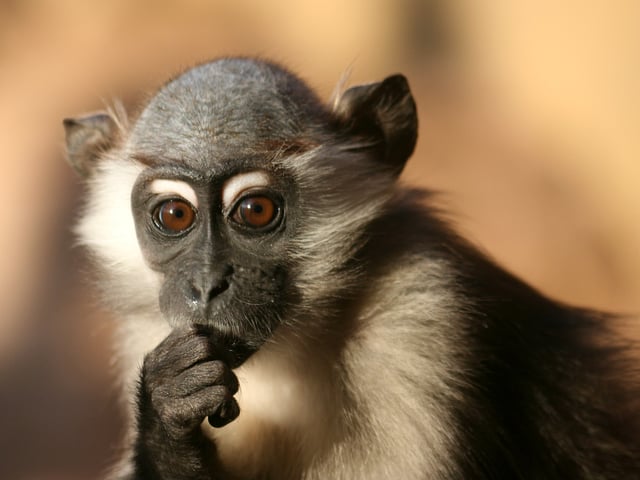
Young cherry-crowned mangabey.
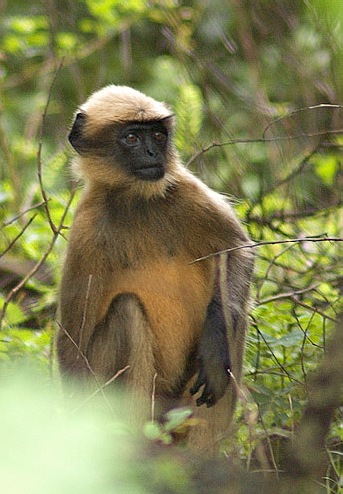
Black-footed gray langur, Semnopithecus hypoleucos
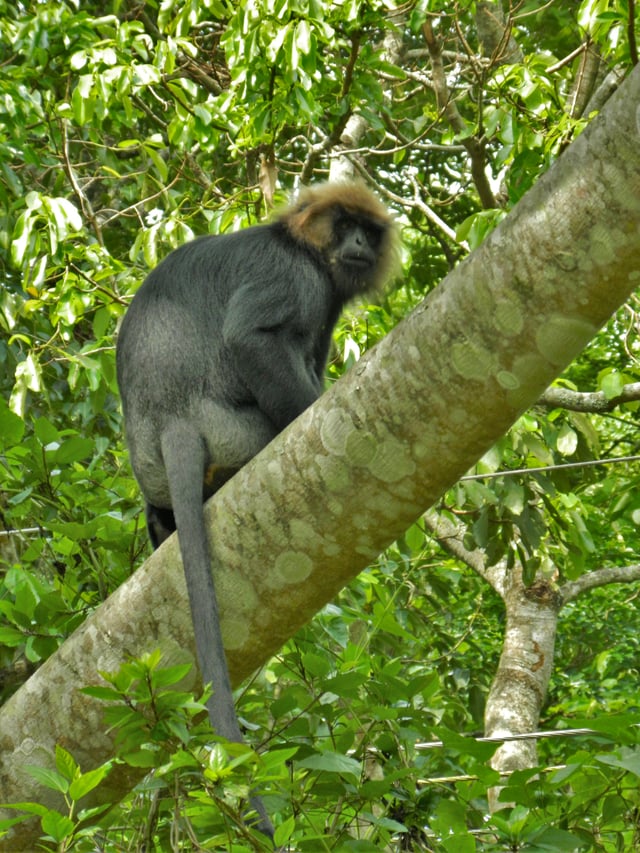
Nilgiri langur (Trachypithecus johnii)
Two subfamilies are recognized, the Cercopithecinae, which are mainly African, but include the diverse genus of macaques, which are Asian and North African, and the Colobinae, which includes most of the Asian genera, but also the African colobus monkeys.
The Linnaean classification beginning with the superfamily is:
Superfamily Cercopithecoidea † Alophia Family Cercopithecidae: Old World monkeys Subfamily Cercopithecinae Tribe Cercopithecini Genus Allenopithecus Allen's swamp monkey, Allenopithecus nigroviridis Genus Miopithecus – talapoins Angolan talapoin, Miopithecus talapoin Gabon talapoin, Miopithecus ogouensis Genus Erythrocebus Patas monkey, Erythrocebus patas Blue Nile patas monkey, Erythrocebus poliophaeus Genus Chlorocebus Green monkey, Chlorocebus sabaeus Grivet, Chlorocebus aethiops Bale Mountains vervet, Chlorocebus djamdjamensis Tantalus monkey, Chlorocebus tantalus Vervet monkey, Chlorocebus pygerythrus Malbrouck, Chlorocebus cynosuros Genus Cercopithecus – guenons Dryas monkey or Salongo monkey, Cercopithecus dryas Diana monkey, Cercopithecus diana Roloway monkey, Cercopithecus roloway Greater spot-nosed monkey, Cercopithecus nictitans Blue monkey, Cercopithecus mitis Silver monkey, Cercopithecus doggetti Golden monkey, Cercopithecus kandti Sykes's monkey, Cercopithecus albogularis Mona monkey, Cercopithecus mona Campbell's mona monkey, Cercopithecus campbelli Lowe's mona monkey, Cercopithecus lowei Crested mona monkey, Cercopithecus pogonias Wolf's mona monkey, Cercopithecus wolfi Dent's mona monkey, Cercopithecus denti Lesser spot-nosed monkey, Cercopithecus petaurista White-throated guenon, Cercopithecus erythrogaster Sclater's guenon, Cercopithecus sclateri Red-eared guenon, Cercopithecus erythrotis Moustached guenon, Cercopithecus cephus Red-tailed monkey, Cercopithecus ascanius L'Hoest's monkey, Cercopithecus lhoesti Preuss's monkey, Cercopithecus preussi Sun-tailed monkey, Cercopithecus solatus Hamlyn's monkey, Cercopithecus hamlyni Lesula, Cercopithecus lomamiensis De Brazza's monkey, Cercopithecus neglectus Tribe Papionini Genus Macaca – macaques Barbary macaque, Macaca sylvanus Lion-tailed macaque, Macaca silenus Southern pig-tailed macaque or beruk, Macaca nemestrina Northern pig-tailed macaque, Macaca leonina Pagai island macaque or bokkoi, Macaca pagensis Siberut macaque, Macaca siberu Moor macaque, Macaca maura Booted macaque, Macaca ochreata Tonkean macaque, Macaca tonkeana Heck's macaque, Macaca hecki Gorontalo macaque, Macaca nigrescens Celebes crested macaque or black "ape", Macaca nigra Crab-eating macaque or long-tailed macaque or kera, Macaca fascicularis Stump-tailed macaque or bear macaque, Macaca arctoides Rhesus macaque, Macaca mulatta Formosan rock macaque, Macaca cyclopis Japanese macaque, Macaca fuscata Toque macaque, Macaca sinica Bonnet macaque, Macaca radiata Assam macaque, Macaca assamensis Tibetan macaque or Milne-Edwards' macaque, Macaca thibetana Arunachal macaque or munzala, Macaca munzala White-cheeked macaque, Macaca leucogenys Genus Lophocebus – crested mangabeys Grey-cheeked mangabey, Lophocebus albigena Black crested mangabey, Lophocebus aterrimus Opdenbosch's mangabey, Lophocebus opdenboschi Uganda mangabey, Lophocebus ugandae Johnston's mangabey, Lophocebus johnstoni Osman Hill's mangabey, Lophocebus osmani Genus Rungwecebus Kipunji, Rungwecebus kipunji Genus Papio – baboons Hamadryas baboon, Papio hamadryas Guinea baboon, Papio papio Olive baboon, Papio anubis Yellow baboon, Papio cynocephalus Chacma baboon, Papio ursinus Genus Theropithecus Gelada, Theropithecus gelada Genus Cercocebus – white-eyelid mangabeys Sooty mangabey, Cercocebus atys Collared mangabey, Cercocebus torquatus Agile mangabey, Cercocebus agilis Golden-bellied mangabey, Cercocebus chrysogaster Tana River mangabey, Cercocebus galeritus Sanje mangabey, Cercocebus sanjei Genus Mandrillus Mandrill, Mandrillus sphinx Drill, Mandrillus leucophaeus Subfamily Colobinae African group Genus Colobus – black-and-white colobuses Black colobus, Colobus satanas Angola colobus, Colobus angolensis King colobus, Colobus polykomos Ursine colobus, Colobus vellerosus Mantled guereza, Colobus guereza Genus Piliocolobus – red colobuses Western red colobus, Piliocolobus badius Pennant's colobus, Piliocolobus pennantii Preuss's red colobus, Piliocolobus preussi Thollon's red colobus, Piliocolobus tholloni Central African red colobus, Piliocolobus foai Niger Delta red colobus, Piliocolobus epieni Ugandan red colobus, Piliocolobus tephrosceles Uzungwa red colobus, Piliocolobus gordonorum Zanzibar red colobus, Piliocolobus kirkii Tana River red colobus, Piliocolobus rufomitratus Genus Procolobus Olive colobus, Procolobus verus Langur (leaf monkey) group Genus Semnopithecus – gray langurs or Hanuman langurs Nepal gray langur, Semnopithecus schistaceus Kashmir gray langur, Semnopithecus ajax Tarai gray langur, Semnopithecus hector Northern plains gray langur, Semnopithecus entellus Black-footed gray langur, Semnopithecus hypoleucos Southern plains gray langur, Semnopithecus dussumieri Tufted gray langur, Semnopithecus priam Genus Trachypithecus – lutungs T. vetulus group Purple-faced langur, Trachypithecus vetulus Nilgiri langur, Trachypithecus johnii T. cristatus group Javan lutung, Trachypithecus auratus Silvery lutung or silvered leaf monkey, Trachypithecus cristatus Indochinese lutung, Trachypithecus germaini Tenasserim lutung, Trachypithecus barbei T. obscurus group Dusky leaf monkey or spectacled leaf monkey, Trachypithecus obscurus Phayre's leaf monkey, Trachypithecus phayrei T. pileatus group Capped langur, Trachypithecus pileatus Shortridge's langur, Trachypithecus shortridgei Gee's golden langur, Trachypithecus geei T. francoisi group François' langur, Trachypithecus francoisi Hatinh langur, Trachypithecus hatinhensis White-headed langur, Trachypithecus poliocephalus Laotian langur, Trachypithecus laotum Delacour's langur, Trachypithecus delacouri Indochinese black langur, Trachypithecus ebenus Genus Presbytis – surilis Sumatran surili, Presbytis melalophos Banded surili, Presbytis femoralis Sarawak surili, Presbytis chrysomelas White-thighed surili, Presbytis siamensis White-fronted surili, Presbytis frontata Javan surili, Presbytis comata Thomas's langur, Presbytis thomasi Hose's langur, Presbytis hosei Maroon leaf monkey, Presbytis rubicunda Mentawai langur or joja, Presbytis potenziani Natuna Island surili, Presbytis natunae Odd-nosed group Genus Pygathrix – doucs Red-shanked douc, Pygathrix nemaeus Black-shanked douc, Pygathrix nigripes Gray-shanked douc, Pygathrix cinerea Genus Rhinopithecus – snub-nosed monkeys Golden snub-nosed monkey, Rhinopithecus roxellana Black snub-nosed monkey, Rhinopithecus bieti Gray snub-nosed monkey, Rhinopithecus brelichi Tonkin snub-nosed monkey, Rhinopithecus avunculus Myanmar snub-nosed monkey, Rhinopithecus strykeri Genus Nasalis Proboscis monkey, Nasalis larvatus Genus Simias Pig-tailed langur, Simias concolor Genus † Mesopithecus † Mesopithecus monspessulanu † Mesopithecus pentelici
Phylogeny
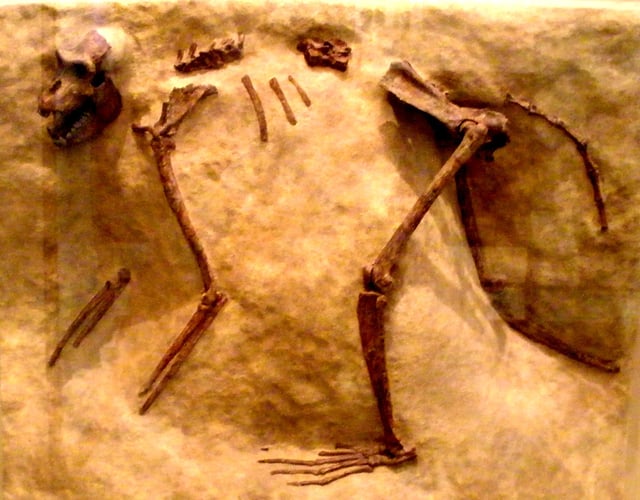
Paracolobus chemeroni fossil
The distinction between apes and monkeys is complicated by the traditional paraphyly of monkeys: Apes emerged as a sister group of Old World monkeys in the catarrhines, which are a sister group of New World monkeys. Therefore, cladistically, apes, catarrhines and related contemporary extinct groups, such as Parapithecidae, are monkeys as well, for any consistent definition of "monkey".
"Old World monkey" may also legitimately be taken to be meant to include all the catarrhines, including apes and extinct species such as Aegyptopithecus,[4] in which case the apes, Cercopithecoidea and Aegyptopithecus as well as (under an even more expanded definition) even the Platyrrhini[5] emerged within the Old World monkeys.
Characteristics
Size
Old World monkeys are medium to large in size, and range from arboreal forms, such as the colobus monkeys, to fully terrestrial forms, such as the baboons. The smallest is the talapoin, with a head and body 34–37 cm in length, and weighing between 0.7 and 1.3 kilograms, while the largest is the male mandrill (the females of the species being significantly smaller), at around 70 cm in length, and weighing up to 50 kilograms.[3]
Appearance
Most Old World monkeys have tails (the family name means "tailed ape"), unlike the tailless apes. The tails of Old World monkeys are not prehensile, as are those of the New World monkeys (platyrrhines).
The distinction of catarrhines from platyrrhines depends on the structure of the rhinarium, and the distinction of Old World monkeys from apes depends on dentition (the number of teeth is the same in both, but they are shaped differently). In platyrrhines, the nostrils face sideways, while in catarrhines, they face downward. Other distinctions include both a tubular ectotympanic (ear bone), and eight, not twelve, premolars in catarrhines, giving them a dental formula of: 2.1.2.32.1.2.3
Several Old World monkeys have anatomical oddities. For example, the colobus monkeys have stubs for thumbs to assist with their arboreal movement, the proboscis monkey has an extraordinary nose, while the snub-nosed monkeys have almost no nose at all.
Behavior and ecology
Habitat
Food
Most Old World monkeys are at least partially omnivorous, but all prefer plant matter, which forms the bulk of their diet. Leaf monkeys are the most vegetarian, subsisting primarily on leaves, and eating only a small number of insects, while the other species are highly opportunistic, primarily eating fruit, but also consuming almost any food items available, such as flowers, leaves, bulbs and rhizomes, insects, snails, and even small vertebrates.[3] The Barbary macaque's diet consists mostly of leaves and roots, though it will also eat insects and uses cedar trees as a water source.[7]
Gestation, birth, and rearing
Gestation in the Old World monkeys lasts between five and seven months. Births are usually single, although, as with humans, twins occur occasionally. The young are born relatively well-developed, and are able to cling onto their mother's fur with their hands from birth. Compared with most other mammals, they take a long time to reach sexual maturity, with four to six years being typical of most species.
Social systems
In most species, daughters remain with their mothers for life, so that the basic social group among Old World monkeys is a matrilineal troop. Males leave the group on reaching adolescence, and find a new troop to join. In many species, only a single adult male lives with each group, driving off all rivals, but others are more tolerant, establishing hierarchical relationships between dominant and subordinate males. Group sizes are highly variable, even within species, depending on the availability of food and other resources.[3]
See also
New World monkey
List of Old World monkey species
List of primates by population
